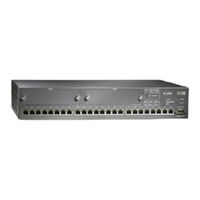Fore Systems ES-2810 Manuals
Manuals and User Guides for Fore Systems ES-2810. We have 2 Fore Systems ES-2810 manuals available for free PDF download: User Manual
Fore Systems ES-2810 User Manual (265 pages)
Ethernet switch
Brand: Fore Systems
|
Category: Network Router
|
Size: 1 MB
Table of Contents
-
-
Front Panel28
-
Rear Panel30
-
Installation31
-
-
Introduction36
-
Power up42
-
-
-
-
Commands55
-
-
Device Tree63
-
Explorer73
-
-
-
Traps86
-
Purpose86
-
-
-
Purpose91
-
-
Tftp95
-
Switching96
-
Spanning Tree101
-
-
Purpose105
-
Using the Mouse105
-
-
General Changes106
-
Renaming a Port106
-
-
Port Mode108
-
-
In this Chapter113
-
-
Purpose113
-
Policy Hierarchy115
-
Adding a VLAN116
-
Deleting a VLAN117
-
-
IGMP Pruning120
-
ATM Elans121
-
Introduction121
-
Configuration121
-
-
-
-
In this Chapter123
-
-
Purpose132
-
RMON History132
-
RMON Alarms132
-
RMON Events133
-
-
Online Help133
-
-
Monitoring Vlans141
-
-
Using the Leds147
-
-
-
Tools Available152
-
-
The Ping Tool153
-
Pinging a Device153
-
-
-
Purpose158
-
-
-
-
In this Chapter165
-
-
Approvals166
-
Physical167
-
Environmental167
-
Leds168
-
Connections168
-
-
-
Consumption169
-
Power Supply169
-
-
-
MAC Addresses170
-
Throughput170
-
Cpu170
-
Memory Sizes170
-
-
-
-
In this Chapter173
-
-
Local Management174
-
Maintenance Mode174
-
Switch Software174
-
-
-
FORE Stack View181
-
Snmp181
-
-
-
-
-
Forwarding Modes192
-
Flow Control196
-
Auto-Negotiation200
-
Port Filters202
-
Introduction202
-
Purpose202
-
MAC Addresses204
-
-
-
IP Addresses206
-
-
Class a Address207
-
Class B Address207
-
Network Numbers207
-
Class C Address208
-
Class D Address208
-
-
-
Spanning Tree210
-
-
Bridging Loops211
-
Bridge Failure212
-
Disabled Ports214
-
7-Hop Limit215
-
-
-
-
VLAN Explanation220
-
IP Learning220
-
Main Window262
-
Troubleshooting265
-
Advertisement
Fore Systems ES-2810 User Manual (60 pages)
Ethernet Switch ATM Uplink Module
Brand: Fore Systems
|
Category: Switch
|
Size: 1 MB
Table of Contents
-
Preface
7 -
-
Advertisement

